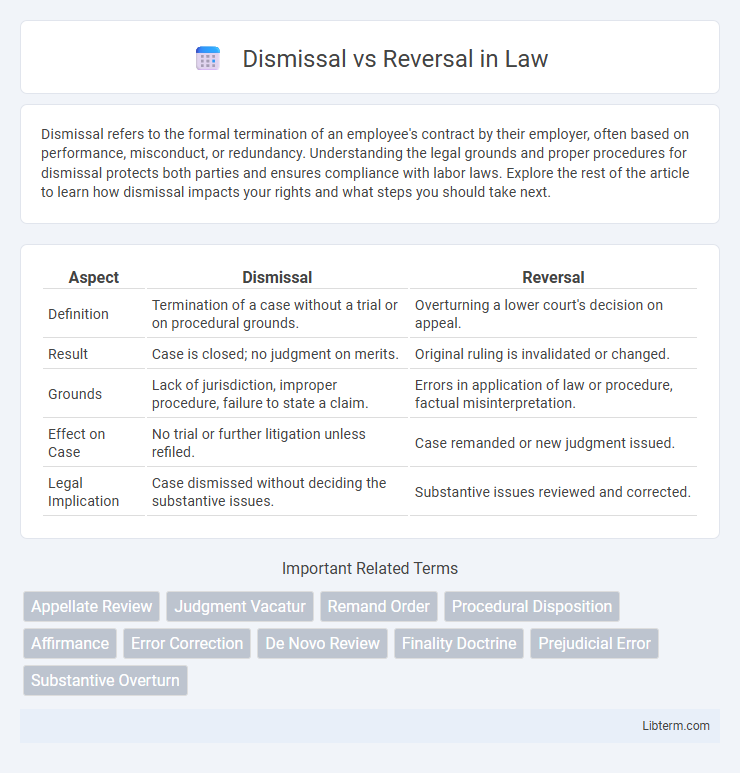Dismissal refers to the formal termination of an employee's contract by their employer, often based on performance, misconduct, or redundancy. Understanding the legal grounds and proper procedures for dismissal protects both parties and ensures compliance with labor laws. Explore the rest of the article to learn how dismissal impacts your rights and what steps you should take next.
Table of Comparison
| Aspect | Dismissal | Reversal |
|---|---|---|
| Definition | Termination of a case without a trial or on procedural grounds. | Overturning a lower court's decision on appeal. |
| Result | Case is closed; no judgment on merits. | Original ruling is invalidated or changed. |
| Grounds | Lack of jurisdiction, improper procedure, failure to state a claim. | Errors in application of law or procedure, factual misinterpretation. |
| Effect on Case | No trial or further litigation unless refiled. | Case remanded or new judgment issued. |
| Legal Implication | Case dismissed without deciding the substantive issues. | Substantive issues reviewed and corrected. |
Introduction to Dismissal vs Reversal
Dismissal and reversal are key legal terms in appellate law with distinct implications for case outcomes. A dismissal terminates a case without ruling on its merits, often due to procedural issues or lack of jurisdiction. Reversal, on the other hand, occurs when an appellate court overturns a lower court's decision, changing the verdict based on legal error or misapplication of law.
Legal Definitions: Dismissal Explained
Dismissal in legal terms refers to a court's decision to terminate a case without a trial, typically due to procedural issues, lack of evidence, or jurisdictional problems. It signifies that the case will not proceed further, but it does not necessarily imply the plaintiff's claims are invalid. Unlike reversal, which invalidates a prior judicial decision on appeal, dismissal ends the current litigation phase without addressing the merits of the case.
Legal Definitions: Reversal Explained
Reversal in legal terms refers to a higher court's decision to overturn or change the outcome of a lower court's ruling, effectively nullifying the original judgment. This occurs when the appellate court finds that legal errors affected the trial's fairness or the application of law. Unlike dismissal, which ends a case without a trial on the merits, reversal directly modifies the final decision of a case after judicial review.
Key Differences Between Dismissal and Reversal
Dismissal terminates a case without ruling on its merits, often due to procedural issues or lack of jurisdiction, while reversal occurs when an appellate court overturns a lower court's decision based on errors in the application of law. A dismissal typically prevents the case from proceeding further, whereas a reversal sends the case back for further action consistent with the appellate ruling. The key difference lies in dismissal ending the lawsuit prematurely and reversal modifying or nullifying a judgment after evaluating the case's substantive legal issues.
Common Scenarios for Dismissal
Dismissal commonly occurs in legal cases when a plaintiff fails to state a claim upon which relief can be granted or when procedural errors prevent the case from proceeding. Examples include lack of jurisdiction, failure to serve proper notice, or untimely filing of a lawsuit. Unlike reversal, which changes a final judgment on appeal, dismissal terminates the case without addressing the merits.
Common Scenarios for Reversal
Reversals often occur in cases involving procedural errors, misapplication of law, or insufficient evidence supporting the original decision. Courts commonly reverse decisions in appeals related to wrongful convictions, improper sentencing, or violations of due process rights. Identifying these scenarios helps clarify when an appellate court may intervene to correct legal mistakes.
Impact on Legal Proceedings
Dismissal terminates a case without addressing the merits, resulting in no final judgment and often allowing the plaintiff to refile. Reversal occurs when an appellate court overturns a lower court's decision, directly impacting the outcome and mandating further proceedings or corrective action. The distinction significantly influences litigation strategy, case duration, and potential legal remedies available to the parties.
Dismissal vs Reversal in Appeals
Dismissal in appeals refers to the court ending a case without reviewing the merits, often due to procedural issues or lack of jurisdiction. Reversal occurs when the appellate court overturns the lower court's decision after evaluating the substantive legal or factual errors. Understanding the distinction between dismissal and reversal is crucial for appellate strategy and affects the potential outcomes for litigants.
Practical Examples and Case Studies
Dismissal occurs when a case is terminated without a trial, often due to procedural issues or lack of evidence, as seen in the landmark case *Ashcroft v. Iqbal*, where the court dismissed claims for failing to state a plausible cause of action. Reversal happens when an appellate court overturns a lower court's decision on substantive grounds, such as in *Brown v. Board of Education*, where the Supreme Court reversed the doctrine of "separate but equal." Practical examples highlight that dismissals prevent unmeritorious claims from proceeding, while reversals correct judicial errors to uphold justice and legal standards.
Conclusion: Choosing the Right Legal Approach
Choosing between dismissal and reversal depends on the case's legal context and desired outcome; dismissal terminates the case without addressing the merits, while reversal alters a prior court decision based on errors. Legal professionals evaluate factors such as procedural posture, evidentiary record, and appellate scope to determine the most strategic approach. An informed decision impacts case resolution, precedent, and client interests in the justice system.
Dismissal Infographic

 libterm.com
libterm.com